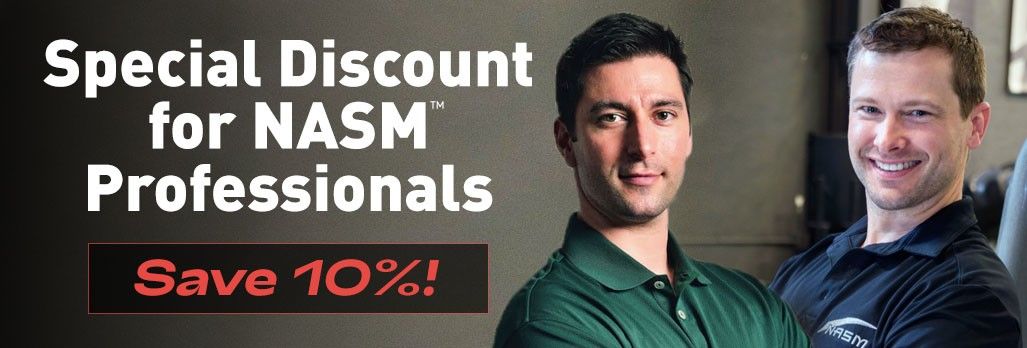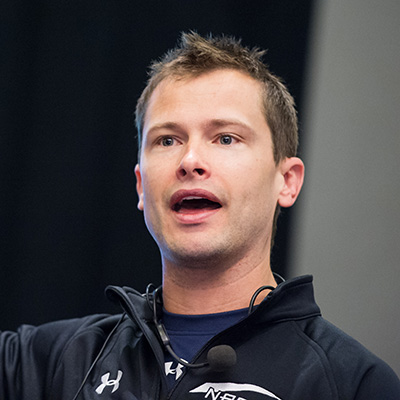Event savings for NASM

NASM professionals receive a discount to the IDEA World Convention or the IDEA World Club & Studio Summit on July 8–12, 2020 in Anaheim, CA.
Get 10% off a full or 1-day registration with code NASM20 at checkout.

Choose the event you'd like to attend
You won't want to miss these NASM sessions, plus over 330 more:

Lower-Back Savers
Session 224 • Thursday, July 9 • 8:35-10:25am
Tony Ambler-Wright, MS
Affecting at least 80% of the population and totaling nearly $200 billion in lost productivity and healthcare costs, lower-back pain is a major public health problem. Undoubtedly, you’ll encounter a client with lower-back pain and you must be competent with corrective and integrated exercise strategies to alleviate discomfort, minimize injury and maximize results. Learn about the common causes of lower-back pain, assessments and progressive exercise solutions, and how to integrate these solutions into client training programs.

Partner-Assisted Stretching: Systematic Stretching for Neuromuscular Efficiency
Session 424 • Friday, July 10 • 7:30-9:20am
Rick Richey, PhD
Could your clients stand to stretch more? In this interactive workshop, you will learn key partner-assisted static stretches, neuromuscular release techniques (strain/counter strain) and muscle energy techniques, within a trainer’s scope of practice, to help increase range of motion, function and neuromuscular efficiency. Plus, you’ll get tips on best practices for hand placement and preferential placement to target specific muscles.

The “Core” and What It’s For
Session 454 • Friday, July 10 • 9:40-11:30am
Rick Richey, PhD
The core has been the subject of many discussions, but what exactly is it? Why is this area so important? How can we best train it? This workshop will provide insights into the anatomy and functionality of the core, how to train it and which training methods are best applied to specific populations. To better understand how to use these methods, you will practice how to apply commonly used and relatively new exercises that will challenge your client’s core and your ability to coach them.

Can You Hear Me Now? How to Communicate So Clients Will Listen!
Session 521 • Friday, July 10 • 4:40-5:40pm
Angie Miller, MS
Communication seems so simple until our communication with someone goes south. Communication is the largest single factor that determines our relationships with others. Whether we’re soft spoken, say it like it is, purge every thought or pretend not to have thoughts, the ability to communicate effectively in our personal and professional lives is essential! Come to this workshop to learn core communication strategies that will help you cultivate strong relationships and keep your career on the fast track.
Plus, don't miss this exclusive preconference session:

| PRICING | IDEA
Member |
Non-Member |
| Early Bird Reg. |
$159 | $179 |
| Regular Reg.
|
$179 | $199 |
All participants will receive an IDEA CERTIFICATE OF COMPLETION.

106 NASM: Practical Applications for Corrective Exercise
WORKSHOP
10:00am–5:00pm (1-hour lunch is on your own)
Tony Ambler-Wright, MS, and Rick Richey, PhD
Corrective exercise (CEx) is a valuable tool for personal trainers to have in their repertoire to help clients improve movement patterns, increase performance and decrease noncontact injuries. However, CEx can often feel too clinical, as if it doesn't belong in a fitness, weight-loss or strength-training program, which may lead trainers to not maximize the integration of corrective modalities. This course will show you how to appropriately and seamlessly integrate different CEx series into your training programs so that your clients register them as exercises and they understand how these movements can help them reach their goals.
In this preconference workshop you will learn how to:
- Perform assessments, including overhead squat, single-leg squat, core stability, range of motion, push-up, and various shoulder girdle assessments
- Identify flexibility, stability and strength compensations
- Employ practical corrective strategies for flexibility and strength imbalances using the NASM CEx model
- Create a cluster of exercises that can be practically integrated as corrective preparation for a workout

